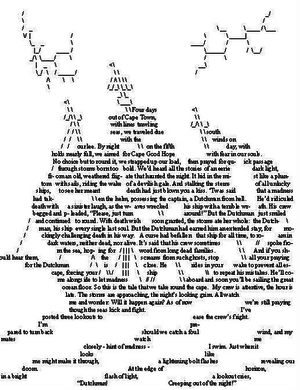User:Inge Hoonte/references: Difference between revisions
Inge Hoonte (talk | contribs) |
Inge Hoonte (talk | contribs) |
||
| Line 20: | Line 20: | ||
[[Image:Picture_1.png|thumb|left|alt=Flying_Dutchman|[[The Flying Dutchman]]'']] | [[Image:Picture_1.png|thumb|left|alt=Flying_Dutchman|[[The Flying Dutchman]]'']] | ||
There are many types of 'digital poetry' such as hypertext, kinetic poetry, computer generated animation, digital visual poetry, interactive poetry, code poetry, holographic poetry (holopoetry), experimental video poetry, and poetries that take advantage of the programmable nature of the computer to create works that are interactive, or use generative or combinatorial approach to create text (or one of its states), or involve sound poetry, or take advantage of things like listservs, blogs, and other forms of network communication to create communities of collaborative writing and publication (as in poetical wikis). | There are many types of 'digital poetry' such as hypertext, kinetic poetry, computer generated animation, digital visual poetry, interactive poetry, code poetry, holographic poetry (holopoetry), experimental video poetry, and poetries that take advantage of the programmable nature of the computer to create works that are interactive, or use generative or combinatorial approach to create text (or one of its states), or involve sound poetry, or take advantage of things like listservs, blogs, and other forms of network communication to create communities of collaborative writing and publication (as in poetical wikis). | ||
Illustration: [[http://www.flickr.com/photos/34092915@N05/5034512849/in/photostream/lightbox/ The Flying Dutchman]] | |||
==Programs== | ==Programs== | ||
[http://www.nltk.org/ Natural Language Toolkit] | [http://www.nltk.org/ Natural Language Toolkit] | ||
Revision as of 20:00, 23 October 2010
Notes
10/22 Meeting with Olia
Talked about Net Artists
irational.org
Chalk text in public space referenced to website address, where visitor is asked where you found the text, why you think it was written.
Olia's online newspaper project
Judd Morrissey
Former Associate Member of Chicago-based performance group Goat Island
'Precession is a data-driven networked poem being developed simultaneously as both a large-scale installation and live performance. The work makes use of original writing and real-time data collection to create visual-poetic arrangements based on inquiries into architecture and the night sky. The piece mixes databased sources, real-time interruptions, and algorithmic composition in an evolving ecology.' >> interesting combination of live performance and live developed text
The Error Engine'We are in the process of creating an installation of the engine in which audience members and remote participants are asked to use their cell phones to send text messages that plant story seeds into the engine.' >> would be interesting to do this during live performance. Improv influenced and adapted by audience.
'The Jew's Daughter is an interactive, non-linear narrative, a storyspace.' >> Go to book page and click on 'Page' to read. I like the changing text generator. Have seen this live, as a performed projection (?). I believe there was a sound track. I'm not sure how interactive this is in the end? The reader/user mostly clicks, doesn't insert itself in the story.
Circulation Room >> Generating poetry combined with video imagery. This is the projected aspect of a live performance. It's not that interesting to watch it on the web, I think you really need the live aspect of bodies physically being in the space with the projection, responding, interacting.
Digital Poetry
There are many types of 'digital poetry' such as hypertext, kinetic poetry, computer generated animation, digital visual poetry, interactive poetry, code poetry, holographic poetry (holopoetry), experimental video poetry, and poetries that take advantage of the programmable nature of the computer to create works that are interactive, or use generative or combinatorial approach to create text (or one of its states), or involve sound poetry, or take advantage of things like listservs, blogs, and other forms of network communication to create communities of collaborative writing and publication (as in poetical wikis).
Illustration: [The Flying Dutchman]

